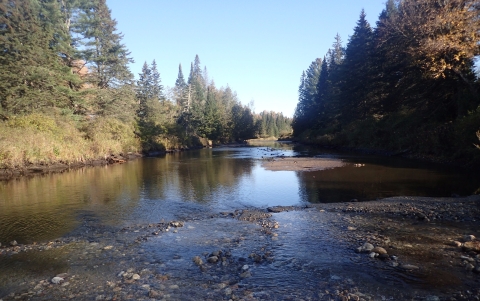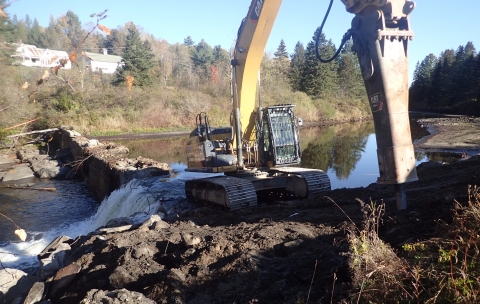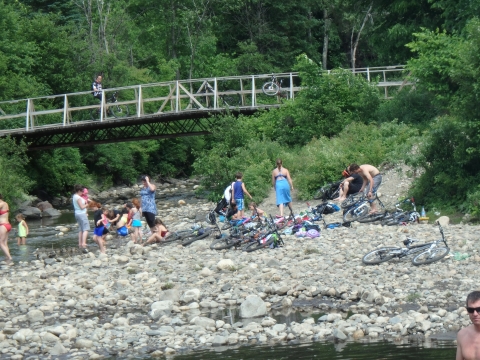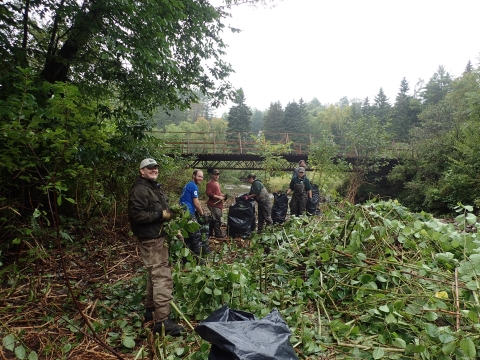Nestled between the rolling green foothills of Burke Mountain and the rushing waters of the Passumpsic River, East Burke is in many ways the quintessential Vermont ski village.
Viewed from above, one stretch of road cuts through the center of town, jam-packed with tourists’ and locals’ cars parked along its side. Crowded with bakeries, cafes, bed and breakfasts, ski lodges, and sporting stores, the little town appears lively and teeming with activity.
Like so many villages that thrive in the shadow of Vermont’s mountains, East Burke relies on the recreation economy from Burke Mountain’s ski slopes in winter, and on the popular mountain bike trails and swift paddling waters of the Passumpsic River in summer.
“This area is to cyclists and kayakers what Stowe is to skiers,” said Service biologist Madeleine Lyttle. “Recreation is their bread and butter.”
But over the years, there had always been one thing barring those waters from reaching their full potential: a crumbling old mill dam on the river, long bereft of its mill and looming 16 feet above any fish attempting to pass.
For decades, the East Burke Dam stood as the last reminder of the town’s saw mill, which burned to the ground in 1958. The concrete structure, which was built atop a wood dam from the 1820s, had often contributed to regular flooding in the town.
But after almost 200 years on the Passumpsic River, it took just five weeks for the Connecticut River Conservancy, the Service, and other conservation partners to dismantle the dam and reopen ninety-nine miles of the river. The project’s completion marked the end of a long history of blocked fish migrations and severe flooding in the community of Burke.
“Homes and businesses downstream should feel safer,” said Ron Rhodes of CRC. “Without the dam raising the water level, the riverbanks will provide natural flood resistance.”
After taking out the large concrete chunks that made up the dam itself, partners also removed 623 truckloads of sediment from the river – lowering the flood elevation level by four feet – restored a 600-foot section of the riverbed, and removed a number of sunken logs that likely originated from the saw mill.
“Now people should be able to fish, kayak, or swim all the way through the area,” said Rhodes.
Rather than being sent to a landfill, the raw materials taken from the site will be recycled: the chunks of concrete from the structure, as well as sand and gravel, have been given to the town of Burke for use in future road work, and the logs found underneath the dam are also being repurposed – local artisans have taken chunks of it to make salad bowls, tables, planks, and even paintings.
“I like the idea of recycling 100-year-old materials,” said Rhodes. “It’s always a plus when we can help the environment while also helping the town.”
The project was initiated by the Passumpsic Valley Land Trust – the owners of the dam – but has since attracted a laundry list of almost 20 different state, local, and federal partners. According to Rhodes, each one has made small contributions of either money or resources, which have collectively allowed the project to go forward.
“It takes all of us coming together, with everyone pitching in where they can,” Rhodes said. “That’s how we get these projects done.”
The finished project provides a guard against future flooding, allows fish to migrate freely, improves access to whitewater paddling, and provides more opportunities for swimmers. Partners have also fortified a nearby bridge for winter snowmobile traffic, and added access steps leading down to the river, making recreation safer for the many families who come to the area.
“The water will be cooler and less stagnant, and way more fun for tubers and kayakers, swimmers – they’re gonna have a blast,” said Lyttle.
But if you ask either partner, the biggest benefit of the project is for the wildlife.
“Ninety-nine miles of open river — that’s the easy answer,” said Rhodes. “It’s a big habitat improvement, and we don’t often get this many miles with one project.”
Since construction concluded, Rhodes said that there have already been more brook trout spotted in an area where few had been seen before. While the project primarily benefits brook trout, other aquatic species in the river are also expected to see a boost from the open water. According to Lyttle, this should mean better fishing prospects for locals and tourists.
In spring 2018, the Service and partners finished planting native trees along the riverbank, providing more habitat for returning wildlife and creating a buffer against soil erosion. Partners are also hoping to use some of the foraged wood to construct a kiosk, which will explain the history of the town, the mill, and the Passumpsic River.
“Anything we can do to improve the area, to leave it better than we found it, we want to do that every chance we get,” said Lyttle.
An invasive species is any plant or animal that has spread or been introduced into a new area where they are, or could, cause harm to the environment, economy, or human, animal, or plant health. Their unwelcome presence can destroy ecosystems and cost millions of dollars.
Learn more about invasive species near the snowmobile bridge.
Partners on this project include:
American Rivers, Caledonia County Natural Resources Conservation District, Connecticut River Conservancy, Eastern Brook Trout Joint Venture, Essex County Natural Resources Conservation District, EPA, USFWS Partners for Fish and Wildlife Program, National Fish and Wildlife Foundation, Passumpsic Valley Land Trust, Region 5 Fish Passage Engineers, Town of Burke, Trout Unlimited (Mad Dog Chapter), Upper Connecticut River Mitigation and Enhancement Fund, USACE, Vermont Agency of Natural Resources, Vermont Dam Taskforce, Vermont Department of Environmental Conservation, Vermont Department of Fish and Wildlife, Vermont Natural Resource Council, Vermont State Historic Preservation Office








